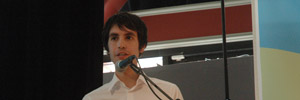
After the four speeches, the Design 2.0 panelists spent some time answering questions from moderator Jessie Scanlon and the audience. I’ve summarized the best ones below. All questions and answers are very roughly paraphrased and to a large extent reflect my interpretation of the dialogue.
JS: Peter, you contrasted Apple’s success with Rhapsody’s clunky integration. Does this suggest that more vertical integration is the way to go?
PR: In the short run, yes, but in the long run everyone benefits from openness. The iPod for example would never have been successful without the benefit of years of openness leading to the mp3 format. Rhapsody, while compatible with more devices, isn’t actually more open per se – it’s just differently closed.
JS: How do you create context for a product if there is none?
SP: The trick is to create hooks upon which a community can build a new context. Google and Amazon have APIs that allow outside developers to create mashups. In’N'Out Burgers has a very simple menu, but it also has a subculture of ‘secret’ items not listed on the menu, that spread virally via fans. In a way it’s bad design because the feature is hidden, but it’s also good design in that it creates passion.
JS: How does power flow through ecosystems?
PR: It’s cliche, but technology both empowers and disempowers. For example, Tivo has changed how people think of TV and given them control over this aspect of their life.
DR: True, but it turns out that the average Tivo user spends 18mn/day just using the Tivo interface, so for every step forward, there are also setbacks. How do we regain those 18 minutes? The question of open vs. closed actually depends on where you are in the power curve: at the beginning a closed system like Apple’s makes sense to get an integrated experience, but as usage norms get figured out, the system eventually opens up.
RW: Another way to empower the customer is mass customization, which is what the car industry is doing with the Scion xB and the Mini Cooper.
SP: Agreed, but in most cases there’s still a terrible lack of power on the user’s side. People are stuck – we have a long way to go.
JS: The left brain is linear and analytic, whereas the right brain is creative. Yet it seems that the design process outlined by Robyn is strictly linear. Is this really the path followed by most projects?
DR: It’s really hard to explain the creative process. You can’t just tell a client that it’s a ‘non-linear fur-ball’, so we describe it as 1->2->3->4 when in reality it’s much more complicated. As the client learns more about the process, they become more comfortable with the more exploratory approach.
Audience question (my question, in fact): Speaking of ecosystems brings up metaphors with the natural world. But natural ecosystems are often described as fragile, easily disrupted environments. Do you have to take care to not damage the ecosystem when introducing a new product, or are product ecosystems much more resilient?
DR: Basically it comes down to whether you want to stay in business after you introduce your product. You can introduce a product with a big splash, but it has to fit into the ecosystems to be successful in the long run. Go in small, learn what goes on, iterate and evolve to achieve fit.
Audience question (by Luke Wroblewski): There seems to be a tension between the fruitfly approach and the ecosystem approach? For Apple and the Monterey Bay Aquarium, it was necessary to create a cohesive ‘elephant’ experience. Comments?
DR: It all depends on the frame of reference. You pick your battles carefully to include as much context as necessary but not so much that it becomes unmanageable. Apple outsourced the internals of the first iPod so it could focus on the big picture.
Anyway, we’re nearing the end of my Design 2.0 coverage. Tomorrow I’ll post some general thoughts on the conference, and then I’ll return to my regular link blogging for a bit!









